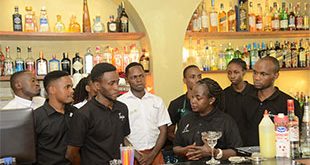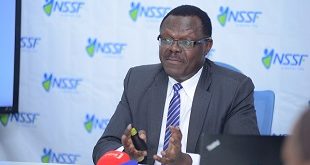
By Eriasa Mukiibi Sserunjogi
But what makes Uganda’s lone nominee for Africa Microfinance Institution of the Year awards tick?
If Ruth Wamulo, 55, of Iganga town in eastern Uganda were on the African Banker of the Year awards panel, she knows she would close her eyes to all the other nominees and vote for BRAC Uganda Microfinance Ltd.
Ruth is partial because Uganda’s sole nominee at this year’s awards in Washington DC on Oct. 8, BRAC Uganda, transformed her life.
She says the organisation saved her from financial dependence on her husband and opened new possibilities in her life.She was among the first Ugandan loan recipients when BRAC opened shop in Uganda in 2006. Her first loan was Shs 200,000, which she used to set up an eating place for Busoga University students.
She has borrowed more and expanded her business. She has built a canteen and bought a piece of land in the neighborhood at Shs 2,500,000 on which she hopes to build a hostel for the students. But the loans aside, Ruth says she has also benefitted from the basic training and encouragement from BRAC officers.
Every Monday Ruth deposits Shs 52,725 on her BRAC loan repayment account and says loan repayment is hard and she has to sacrifice to make the weekly repayments. Still, she needs to check her notebook to find out for how many weeks she has to make installment loan repayments; it is not something she pays a lot of attention to. Instead, she adds, she cannot imagine life without BRAC.

She is not alone. Their fortunes may vary, but BRAC’s clientele has grown phenomenally, to over 130,000 borrowers over the four years they have been in operation in Uganda.
No wonder BRAC Uganda was one of five institutions nominated for this year’s Africa microfinance bank of the year award.
Also nominated were Equity Bank Kenya Ltd, which won the award last year and has since extended its operations to Uganda,Amhara Credit and Saving Institution (ACSI) of Ethiopia, First Microfinance Foundation and National Bank for Development, both of Egypt.
BRAC is an acronym for the Bangladesh Rural Advancement Committee. It was initiated in 1972 by Sir Fazle Hasan Abed as a small-scale relief and rehabilitation project to help returning war refugees after the Bangladesh Liberation War of 1971.
Later, BRAC turned towards long-term development needs and re-organised itself as a multifaceted development organisation focusing on the empowerment of the poor and landless, particularly women and children. It later took on an international character and now has chapters in the US and UK. Its development activities are concentrated in Asia and Africa.
Sir Fazle, for his contribution to the fight against poverty and uplifting standards of human life, was on Aug.25 named among the Group of Eminent Persons by UN Secretary General Ban Ki Moon “to advise on the support needed to help the world’s poorest nations achieve their development targets” ahead of the Fourth UN Conference on the Least Developed Countries (LDCs) due to take place in Istanbul, Turkey, from May 30 to June 3, 2011.

The group consists of 10 members who were chosen for their “high international stature, expertise and strong commitment to global development.” Deputy Bank of Uganda Governor Louis Kasekende is one of them.
According to information on its website, BRAC is now a global institution working in Asia and Africa through its development interventions, reaching over 110 million people, 72 percent of whom are women. Its guided by the vision of “a just, enlightened, healthy, democratic society free from hunger, poverty, environmental degradation, and all forms of exploitation based on age, sex, religion and ethnicity”.
Registered in Uganda as a nongovernmental organization, BRAC is engaged in several activities, ranging from microfinance, agriculture and livestock support programs, supporting small enterprises, health, adolescent development and education and training.
It started its micro finance program in Uganda in 2006 with 10 branch offices and now has 115 offices in 42 of the 113 districts with an eye to opening more in the near future.Khondoker Ariful Islam, the founding BRAC Uganda Country Program Head, says BRAC is currently the largest NGO in the developing world, and in Uganda.
BRAC provides microcredit at an interest rate of 22 percent per year, which is somewhat high, Khondoker admits. But he says operating costs are high, estimated at 5 percent and the loan loss rate is 2 percent. He says BRAC borrows the loanable funds at 15 per cent per year, which he says is also very high. BRAC’s monthly interest rate is 1.8 per cent.

BRAC Uganda’s microloans are of two types as developed in Bangladesh: microloans exclusively for women to generate income activities at micro and small-scale levels; and micro-enterprise loans, designed for small entrepreneurs, who need additional capital to expand their existing businesses.
The loans are delivered through small borrower groups, comprising beneficiaries. After setting up the branch offices, the BRAC officers identify the target population of the area, usually within a radius of seven kilometers from the area office. Each group usually consists of 30 members and they act as effective platforms for monitoring, as group members are collectively accountable to one another for their actions. The loans follow a structured incremental system, usually beginning with Shs 100,000.
The microfinance program has been expanding in new areas to cover ‘un-served or stranded poor people specially women living in the villages or in urban slums’.
Khondoker has been at it for a long time. He joined the BRAC organization 27 years ago, soon after graduation. He worked in Indonesia, Afghanistan and Sudan before being posted to Uganda as the inaugural country head.
Talking to The Independent at BRAC’s country offices in Nyanama, Kampala, Khondoker said they have enjoyed success in Uganda because of three main reasons. He says their deep penetration in rural areas enables them to reach and serve the most vulnerable people. “We have many offices beyond district towns; reaching deep in villages where the biting poverty is,” he says. He says over half of their offices are in typical rural areas, unlike most microfinance institutions that prefer to only set up offices at district headquarters where there are richer borrowers. Over half of BRAC’s offices are located away from district headquarters.

Brac’s second unique feature, according to Khondoker, is the absence of shareholders within its ranks. All they have is a governing body.”We therefore don’t pay a lot of attention to such things as profit and dividends; the most important thing for us is to serve and improve people’s lives.” Because BRAC is not run with the intention to make profit, he explains, the interests of the beneficiaries take center stage.
The third unique element Khondoker points out is what he calls the Microfinance Multiplied Approach. By this approach, he says, BRAC provides several other essential services apart from microfinance. Such services include equipping farmers with skills like carrying out artificial insemination, providing quality seeds, offering training in basic business management and related activities and providing quality livestock.
These services, argues Khondoker, are crucial to rural people. “Some of them usually have the money but they do not have where to buy or access some of these essential services and inputs. By taking them closer to the rural people, we aid their transformation.”
He adds that the support BRAC accords its clients encourages them to cooperate and repay their loans on schedule, explaining the organization’s minimal default rate of less than 2 per cent.
By the end of August, BRAC had covered 98 per cent of its operating costs and Khondoker says they project that they will have ‘broken even’ by the end of March 2011. When BRAC eventually makes profits, he says, they will be reinvested.
For now, BRAC receives support from, among others, BRAC International, BRAC USA, BRAC UK, Living Goods Foundation, Nike International, Master Card International and Whole Planet Foundation.
 The Independent Uganda: You get the Truth we Pay the Price
The Independent Uganda: You get the Truth we Pay the Price



